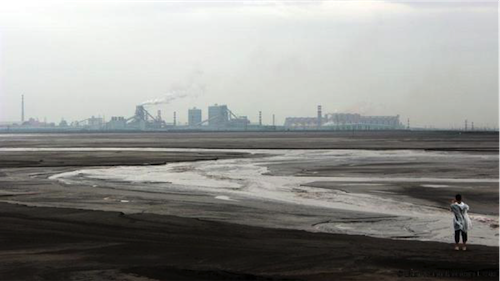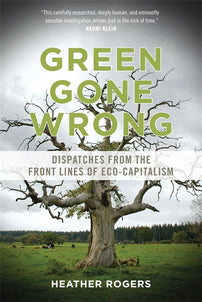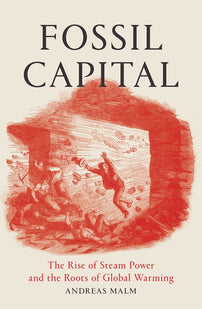End the “Green” Delusions: Industrial-scale Renewable Energy is Fossil Fuel+
Industrial-scale renewable energy does nothing to remake exploitative relationships with the earth, and instead represents the renewal and expansion of the present capitalist order.

Renewable energy is not the solution we think it is. We have inherited the bad/good energy dichotomy of fossil fuels versus renewable energy, a holdover from the environmental movement of the 1970’s that is misleading, if not false. Fossil fuels are correctly understood to be at the heart of capitalism, industrialism, and state formation, the results of which have been ecologically catastrophic. 1 Meanwhile, industrial-scale renewable energy has emerged as the protagonist of our times, positioned as a solution to our ever-increasing energy consumption. Along with market-based conservation and “natural capital” policy making, it is taken to be among the central mitigating forces against climate change and ecological degradation. 2
With the rise of the green economy and climate change legislation, renewable energy includes the harnessing of wind, solar, and other apparently infinite “natural resources” to meet energy consumption on an unprecedented, ever expanding scale. However, contrary to the claims of its proponents, it by no means adequately addresses the real problem posed by current levels of energy consumption, which are driven by capitalist growth imperatives that ultimately cause the ecological degradation and climate change we see today. A focus on the technocratic issue of energy consumption often leaves unchallenged the political-economic violence of intrinsic to the social system that such energy powers.
Industrial-scale renewable energy does nothing to remake the exploitative relationships with the earth and ecosystems created and reproduced by “industrialized humans” — people acclimated to and dependent upon an industrial capitalist way of life. The excessive concern with possible energy solutions within capitalism as opposed to more fundamental social transformations expresses our inability to imagine any other way of living, blinding us to the deeper socio-ecological insurrection that climate change has made necessary.
Industrial-scale renewable energy and the grid-centric systems it powers represent the renewal and expansion of the present political and capitalist order. Not only are existing social discontents like inequality, discrimination, and exploitation reinforced by renewable energy, but the amount of infrastructure it presently requires clearly indicates the ecological costs involved in its full implementation. The wind and solar parks that span across fields and hillsides as far as the eye can see are harbingers of what this new energy system would look like. Where does all this metal come from, how much energy can it produce, and what kind of society do these systems propel and enable?
—
In 1980, American Indian Movement activist Russell Means explained the uncomfortable reality of extractivism in Native territory. Confronting a room of revolutionary Communists about their desire for industrialism, Means said:
Right now, today, we who live on the Pine Ridge Reservation are living in what Euro society has designated a "national sacrifice area." What this means is that we have a lot of uranium deposits here and Euro culture (not us) needs this uranium as energy production material. The cheapest, most efficient way for industry to extract and deal with the processing of this uranium is to dump the waste byproducts right here at the digging sites. Right here where we live. This waste is radioactive and will make the entire region uninhabitable forever. This is considered by industry, and the white society which created this industry, to be an ‘acceptable’ price to pay for energy resource development. Along the way they also plan to drain the water-table under this area of South Dakota as part of the industrial process, so the region becomes doubly uninhabitable. The same sort of thing is happening down in the land of the Navajo and Hopi, up in the land of the Northern Cheyenne and Crow, and elsewhere. Over 60 percent of all U.S. energy resources have been found to lie under reservation land, so there's no way this can be called a minor issue. For American Indians it's a question of survival in the purest sense of the term. For white society and its industry it's a question of being able to continue to exist in their present form.
We are resisting being turned into a national sacrifice area. We're resisting being turned into a national sacrifice people. The costs of this industrial process are not acceptable to us. It is genocide to dig the uranium here and to drain the water-table, no more, no less. So the reasons for our resistance are obvious enough and shouldn't have to be explained further. To anyone. 3
Like the mining of fossil fuels, the siting and implementation of renewable energy systems entails the creation of such sacrifice zones, often on Indigenous land. These projects have thus confronted considerable pushback from rural and Indigenous populations, and the struggles around extraction outlined by Means have only continued to intensify. 4 By clinging to ideas like “sustainable development” and the “green economy,” progressives and other conscientious citizens are staking the future of the planet on dubious mechanisms of oversight, rife with conflicts of interest. The proliferation of voluntary UN standards, corporate social responsibility initiatives, private auditing firms, 5 and free, prior, and informed consent (FPIC) are but “band aids of good intentions.” 6 They ultimately cover over the true costs of extractivism, especially for the Indigenous people most affected by it.
The distinctions drawn between fossil fuels and renewable energy involve a sleight of hand that masks the continued ecological degradations necessary for the continuation of consumer society and its ecological modernization. 7 Renewable energy requires immense amounts of mineral and fossil fuel resources, both in the construction of machinery necessary for extraction and for the manufacturing, transportation, construction and operation of wind turbines and other industrial-scale renewable energy systems.
For all these reasons, instead of conceiving renewable energy as a “green” environmental solution, industrial or utility-scale renewable energy is more accurately referred to as “Fossil Fuel+.”
—
Let us focus the discussion on a single renewable form: wind. Wind energy is something of a poster child for renewable energy in general, and it is increasingly becoming a preeminent approach to climate change mitigation. Through my fieldwork in the Isthmus of Tehuantepec region of Oaxaca, Mexico, where I was embedded for six months in a polícia comunitaria, I have been able to witness firsthand the struggles and negative outcomes involved in the implementation of this form of renewable energy, even as it continues to be encouraged and incentivized by national and international climate change mitigation programs.
Consider, for example, the resources required to construct a single two-megawatt wind turbine. One of these turbines uses roughly 150 metric tons of steel for reinforced concrete foundations, 250 metric tons for the rotor hubs and nacelles, and 500 metric tons for the tower. 8 This also includes 3.6 tons of copper per megawatt. 9 Furthermore, industrial steel production is impossible without burning coal, as metallurgical coal — or coking coal — is a vital ingredient in the process. 10 Now, imagine regions like the Isthmus of Tehuantpec, where roughly 1,700 wind turbines operate to provide energy to Walmart, Grupo Bimbo, industrial construction, mining, and other companies and industries. 11 These turbines require significant amounts of mining. But every stage of the mining process, from extraction, processing, manufacturing, transport, construction and, to some degree, operation, requires a large expenditure of fossil fuels, a fact that is often neglected in the ecological accounting of wind energy. According to Guezuraga et al., the main consumers of energy and producers of CO2 for the turbines are “the production of stainless steel, followed by concrete and cast iron,” while “plastic production represents the most energy intensive process of all materials.” 12 While from the perspective of carbon accounting, steel, concrete, and cast iron production are the main consumers of energy, the ecological cost of mining and processing the rare earth minerals required to create permanent magnet generators in wind turbines remains publically neglected.

Baotou Mining and Processing Area. Photo: Liam Young/Unknown Fields
Where do these minerals come from, and what is the ecological cost of their extraction? Many of the rare earth minerals required for the operation of the turbines, such as dysprosium, praseodymium neodymium, terbium, come from places like Baotou, Inner Mongolia, and Ganzhou, South East China, where between the late 1980s and 2015 some 85-98% of rare earth minerals used in wind turbines, electric cars, smart phones and other technologies, were produced. 13
The costs?
A BBC report from 2015 called the Baotou mining and processing area “hell on Earth,” a terrifying, dystopian industrial environment filled with pollution and cluttered with factories, pipelines, high-tension wires, and artificial lakes oozing “black, barely-liquid, toxic sludge” that “tested at around three times background radiation.” 14
Rare earth mining is also disastrously inefficient. Mined with open pit, underground, or leached in-situ methods, rare earth ore deposits contain “low concentrations [of desired minerals] ranging from 10 to a few hundred parts per million by weight.” 15 Most concerning, however, is that “[t]he mining and processing steps for refining of rare earths tend to be energy, water and chemical intensive with significant environment risks affecting water discharges (radionuclides, mainly thorium and uranium; heavy metals; acid; fluorides), tailing management and air emissions.” 16

Baotou Lake, Mongolia. Photo: Liam Young/Unknown Fields
Wind energy thus involves socially and ecologically destructive mining processes that produce large amounts of mining tailings (or waste) containing heavy metals, thorium, and radioactive materials that goes into the air, water, soil, animals and people — the quantity and intensity of which is difficult to measure, not only for political but also epistemic reasons, making accounting for all ecosystem impacts not only costly but impossible.
Amory Lovins points out that, while in theory wind turbines could be built without rare earth minerals (geared turbines), this is not currently the case for the majority of utility-scale wind parks — especially wind turbines located offshore or in areas with extremely strong winds. 17 Like other industrial enchantments (such as computers or smart technologies), wind farms continue to require levels of extraction that generate toxic and radioactive waste excluded from carbon accounting and often exempt from outdated life cycle assessments. 18 While further research on the exact levels of ecocide and political violence is necessary, the fact remains that the green economy is expanding demand for destructive mining of iron ore, copper, oil, and rare earth minerals. This in turn is part and parcel of the creation and expansion of sacrifice areas engulfing entire regions of China and the mountains, rivers, and forests across the world.
—
The political and environmental costs of implementing these renewable wind energy systems are also high. Scale, placement, mitigation practices, and energy-use are foundational for assessing the viability and long-term socio-ecological sustainability of wind turbines. This means taking cognizance of the quantity and location of large-scale turbines, as well as the various political and socio-geographical factors involved in their construction.
For example, while it is ill advised to place them on lands used by semi-subsistence Indigenous groups, within 1.5 kilometers of people’s homes, or in areas with fresh ground water, farming, and fishing areas, this is precisely what has happened on the Isthmus of Tehuantepec. 19 The construction and placement of wind turbines requires the creation of roads that clear trees and animal habitats and compact soil. They also require the creation of wind turbine foundations that range, depending on the site, between 7-14 meters (32-45 ft.) deep and about 16-21 meters (52-68 ft.) in diameter. The foundations require the filling of ground water with solidifying chemicals before filling them with steel reinforced concrete. Then, during operation, leaking oil seeps into the ground where animals graze and into water wells where people drink. 20 And this leaves aside the effects of concrete production, as well as the violence involved in building wind or other renewable energy systems on Indigenous territory. 21 On top of all this, each wind turbine only has roughly a 30-40 year lifespan before it needs to be decommissioned and, hopefully, recycled, which is currently done at an unsatisfactory rate over all. 22
These unpleasant facts are why renewable energy should really be called fossil fuel+. The + indicates the added benefit of the renewable component or multiplier present in renewable energy systems while simultaneously acknowledging their dependence on fossil fuel based-technologies and extractivism. Because the +, or renewable component, is dependent on fossil fuels, it is not entirely positive. A focus on the benefits of renewable energy systems overlooks the simple but paramount question: what is all this energy used for?
Renewable energy is opening and widening new wind, solar, and other natural resource frontiers, and in doing so it is renewing capitalism as well. In addition to private industry, militaries are beginning to take an increased interest in renewable energy systems. The same techniques and technologies that are helping corporations expand in ostensibly “green” directions will be applied to power military infrastructures and equipment. Whether the question is of solar in the Middle East, wind power in Mexico, or aircraft carriers that run on biofuels, these relations support the expansion of capitalism while obscuring its wrenching crises — thereby obstructing effective people-led or, if we are to be generous, government-led action. 23
Industry and security forces are beginning to acknowledge their ecologically destructive operations, and repressive forces are looking for ways to become ecologically “sustainable.” Such “sustainable violence” is not just the result of “bad governance.” 24 It is inextricably bound up in industrial extraction and efforts of economizing on the destructive and repressive actions of governments, industry and security forces involved in the expansion of industrial-scale renewable energy systems.
Finally, fossil fuel industries — whether coal, natural gas, or oil — are beginning to invest and use renewable industry to legitimize their resource extraction operations and diversify their energy related holdings. Examples range from Gas Natural Fenosa, which is investing in wind parks in Mexico, 25 to RWE in Germany, operator of the largest coal mine in the country, which is setting up their own green daughter company — “Innogy” — to invest in wind energy and other “renewables” after spending years subverting and lobbying against them. 26 Grupo Mexico is also buying wind in Mexico and solar parks in the US to cloak their company in a “green” image. Meanwhile, they are powering the extraction of raw materials with renewable sources. 27 With Andrea Brock, I have called this the “renewable energy-extraction nexus,” which demonstrates the intimate relationship between forms of extraction — whether wind, natural gas, coal, or copper — necessary for renewable energy development and the continued subsumption of the earth and its inhabitants to industrial society. 28
The renewable energy-extraction nexus embodies the network of extractive industries and utility providers that form the skeleton of the state. This includes the intricate web of subsidies, collaboration and, at times, competition that renews the techno-industrial capitalist machine, spreading its infrastructure and values across the planet. This expansion happens at a great disregard for the costs involved, whether for people (particularly Indigenous or rural communities in both the Global North and South), animals, plants or geophysical nature.
The preceding considerations allow us to recognize renewable energy as renewing destruction. It entails revived and intensified relations of domination that have much in common with colonial and center-periphery dynamics. When people embrace renewable energy systems, many do not realize that they require various forms of violence against people, environments, and animals, which must remain hidden for obvious reasons. These systems, which require concrete, steel, copper, rare earth minerals and, by extension, fossil fuel and mineral extraction, are made acceptable by being placed out of sight and out of mind, in the materially poor, rural, and Indigenous territories of the Global South and North.
When liberals, progressives, “the Left,” and even environmental justice activists applaud the large-scale transition to renewable energy, they ignore the many hazards that would otherwise be unacceptable to them. Displacing fossil fuel industries to the Global South, where there are fewer environmental regulations and political rights, makes possible the use of excessive forms of state-private security violence against anyone who might protest them. Furthermore, the material necessary for renewable energy can only result in an increase in extractivism in the Global South and all the negative consequences this entails for people on the ground. If we do not confront these facts, then the solution of today — like previous energy systems and regime changes — will likely result in the complicated tyrannies of tomorrow. Recognizing renewable energy as Fossil Fuel+ is a first step to combat the fairytale of renewable energy. By highlighting the myths surrounding renewable energy, we also create the groundwork for greater environmental considerations and the enactment of radical ecological alternatives that address the roots of consumer society and its marketed solutions.
Notes
1. Malm A. (2016) Fossil Capital: The Rise of Steam Power and the Roots of Global Warming, London: Verso Books.
2. see Sullivan S. (2009) "Green Capitalism, and the Cultural Poverty of Constructing Nature as Service Provider," Radical Anthropology 3: 18-27; Huff A and Brock A. (2017)" Intervention–'Accumulation by Restoration.'" Available at: https://antipodefoundation.org/2017/11/06/accumulation-by-restoration/.
3. Means R. (1985) "The Same Old Song," in Churchill W (ed) Marxism and Native Americans. Boston: South End Press, p. 25
4. Dunlap A. (2017a) "Counterinsurgency for Wind Energy: the Bíi Hioxo Wind Park in Juchitán, Mexico." The Journal of Peasant Studies: 1-23; Dunlap A. (2018) "Insurrection for Land, Sea and Dignity: Resistance and Autonomy against Wind Energy in Álvaro Obregón," Mexico Journal of Political Ecology 25: 1-22; Siamanta ZC. (2017) "Building a Green Economy of Low Carbon: the Greek Post-crisis Experience of Photovoltaics and Financial 'Green Grabbing.'" Journal of Political Ecology 24: 258-276; Finley-Brook M and Thomas C. (2011) "Renewable Energy and Human Rights Violations: Illustrative Cases from indigenous Territories in Panama," Annals of the Association of American Geographers 101: 863-872; Lawrence R. (2014) "Internal Colonisation and Indigenous Resource Sovereignty: Wind Power Developments on Traditional Saami Lands," Environment and Planning D: Society and Space 32: 1036-1053;
5. Brock A and Dunlap A. (2018) "Normalising Corporate Counterinsurgency: Engineering Consent, Managing Resistance and Greening Destruction Around the Hambach Coal Mine and Beyond," Political Geography 62: 33-47.
6. FPIC are voluntary UN standards to provide free, prior and informed consent to Indigenous Populations before implementing megaprojects or other development schemes or their territory. The idea is to allows for their informed decision making to either accept or deny these proposed projects. The politics and practice, however, is highly suspect and riddle with contention and various interpretations. For an overview, see Dunlap A. (2017) "'A Bureaucratic Trap': Free, Prior and Informed Consent (FPIC) and Wind Energy Development in Juchitán, Mexico," Capitalism Nature Socialism: 1-21
7. Bonds E and Downey L. (2012) "Green Technology and Ecologically Unequal Exchange: The Environmental and Social Consequences of Ecological Modernization in the World-System," Journal of World-Systems Research 18: 167-186.
8. Smil V. (2016) "To Get Wind Power You Need Oil." Available at: http://spectrum.ieee.org/energy/renewables/to-get-wind-power-you-need-oil.
9. Smith P. (2014) "Soaring Copper Prices Drive Wind Farm Crime." Available at: http://www.windpowermonthly.com/article/1281864/soaring-copper-prices-drive-wind-farm-crime.
10. Dıez M, Alvarez R and Barriocanal C. (2002) "Coal for Metallurgical Coke Production: Predictions of Coke Quality and Future Requirements for Cokemaking," International Journal of Coal Geology 50: 389-412.
11. Dunlap A. (2017b) "'The Town is Surrounded:' From Climate Concerns to Life under Wind Turbines in La Ventosa," Mexico Human Geography 10: 16-36.
12. Guezuraga B, Zaunera R and Pölz W. (2012) "Life Cycle Assessment of Two Different 2 MW Class Wind Turbines," Renewable Energy 37, pp. 40-1.
13. Hongiao L. (2016) "The Bottleneck of a Low-carbon Future." Available at: https://chinadialogue.net/article/9209-The-bottleneck-of-a-low-carbon-future.
14. Maughan T. (2015) "The Dytopian Lake Filled by the World's Tech Lust," pp. 1, 7. Available at: http://www.bbc.com/future/story/20150402-the-worst-place-on-earth.
15. Yang XJ, Lin A, Li X-L, et al. (2013) "China's Ion-adsorption Rare Earth Resources, Mining Consequences and Preservation," Environmental Development 8, p. 133.
16. Haque N, Hughes A, Lim S, et al. (2014) "Rare Earth Elements: Overview of Mining, Mineralogy, Uses, Sustainability and Environmental Impact," Resources 3, p. 621.
17. Lovins A. (2017) "Clean Energy and Rare Earths: Why Not to Worry." Available at: https://thebulletin.org/clean-energy-and-rare-earths-why-not-worry10785.
18. Kiezebrink V, Wilde-Ramsing J and Kate Gt. (2018) "Human Rights in Wind Turbine Supply Chains: Towards a Truly Sustainable Energy Transition." Available at: https://www.somo.nl/wp-content/uploads/2018/01/Final-ActionAid_Report-Human-Rights-in-Wind-Turbine-Supply-Chains.pdf; also keep an eye out for Judith Pigneur's forthcoming work.
19. Endnote 3 & 12
20. Ibid.
21. One example, see Dunlap A. (2018d) "The 'Solution' is Now the ‘Problem:’ Wind Energy, Colonization and the ‘Genocide-Ecocide Nexus’ in the Isthmus of Tehuantepec, Oaxaca," The International Journal of Human Rights 42: 550-573; see also endnote 4, Dunlap.
22. Habib K and Wenzel H. (2014) "Exploring Rare Earth Supply Constraints for the Emerging Clean Energy Technologies and the Role of Recycling," Journal of Cleaner Production 84: 348-359.
23. Dunlap A. (2017) "Wind Energy: Toward a 'Sustainable Violence' in Oaxaca, Mexico," NACLA 49: 483-488; Bigger P and Neimark BD. (2017) "Weaponizing Nature: The Geopolitical Ecology of the US Navy’s Biofuel Program," Political Geography 60: 13-22.; The Military is Going Green with Arnold Schwarzenegger. Available at: http://channel.national geographic.com/years-of-living-dangerously/videos/the-militarys-going-green/
24. Dunlap.
25. Endnote 3, Counterinsurgency for Wind Energy
26. Endnote 5
27. Endnote 12 & GrupoMexico. (2016) Ingenia 02, p. 32. Available at: http://www.gmexico.com/site/images/documentos/ingenia/INGENIA02.pdf.
28. Dunlap A and Brock A. (Forthcoming 2019) "When the Wolf Guards the Sheep: Green Extractivism in Germany and Mexico," in: Springer S, Jennifer M, Locret M, and Maleea A. (eds) Anarchist Political Ecology Volume 1. Oakland: PM Press.
Alexander Dunlap is a post-doctoral researcher in the Department of Social and Cultural Anthropology at Vrije Universiteit Amsterdam. Doctoral fieldwork researched the social impact and conflict generated by wind energy development in the Isthmus of Tehuantepec region of Oaxaca, Mexico. This has led to research in Germany, Peru, and France, in addition to current research examining the material and economic relationships linking fossil fuel and mineral industries with renewable energy development. Alexander has previously published in the journals: Anarchist Studies, Review of Social Economy, Geopolitics, Journal of Peasant Studies, Human Geography, Capitalism, Nature, Socialism, Forum of Social Economy, Political Geography, NACLA: The Report on the Americas, The International Journal of Human Rights, and a recent paper in the Journal of Political Ecology titled, "'Insurrection for Land, Sea and Dignity: Resistance and Autonomy against Wind Energy in Álvaro Obregón, Mexico.'"
[book-strip index="1" style="display"]



